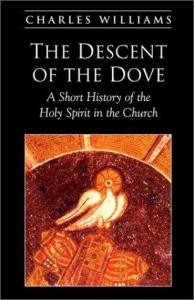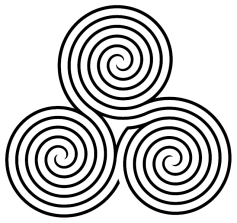

Thoughts on Charles Williams’ “Descent of the Dove”
This blogpost was written by Fr. Chris and published on a site devoted to Charles Williams, one of the “Inklings” in C. S. Lewis’ and Tolkien’s writers group. It appeared on the site on December 6, 2014.
Thoughts on Charles Williams’ Descent of the Dove
Today’s post is written by guest blogger Chris Schutte. Here’s his brief bio:
 I’m a native Arizonan and studied History and Classics at the University of Arizona. I received an MDiv from Gordon-Conwell Theological Seminary near Boston. I’m currently the pastor of Christ Church in Phoenix. I’m married to Tracy and have three fun and crazy children: Owen (11), Anna (9), and Claire (7). I’m slowly accepting the fact that I have a dog . . . I love wandering around in the woods and playing in the ocean, and I’m way too emotionally involved in University of Arizona sports. I’m on Twitter at @chrismschutte.
I’m a native Arizonan and studied History and Classics at the University of Arizona. I received an MDiv from Gordon-Conwell Theological Seminary near Boston. I’m currently the pastor of Christ Church in Phoenix. I’m married to Tracy and have three fun and crazy children: Owen (11), Anna (9), and Claire (7). I’m slowly accepting the fact that I have a dog . . . I love wandering around in the woods and playing in the ocean, and I’m way too emotionally involved in University of Arizona sports. I’m on Twitter at @chrismschutte.
Charles Williams’ Descent of the Dove has been sitting on my shelf for over a decade. I’ve wanted to read it since a friend and mentor of mine told me that it was his favorite book on the Holy Spirit, but hadn’t quite gotten around to it.
Earlier this fall, as I was seeking a deeper understanding of and relationship with the Holy Spirit, I decided finally to jump in. I’m not sure that it was the Spirit himself who spoke, as he did to St Augustine, “Tolle, lege!” but, either way, I’m thankful to have read it, and am grateful for an opportunity to offer some reflections on this brilliantly written book.
A caveat: I’m not an expert on Williams. I’m aware that he was an Inkling, and that he was, well, odd. My only exposure to Williams’ writing was nearly 13 years ago when my bishop suggested that I read The War in Heaven, which I read (after all, I had just taken a vow of obedience to the guy!), but, honestly, I don’t remember much.
Williams is eminently quotable (although in a pre-Twitter sense), and is a master of language, thus it is hard to focus my reflections on just a few general themes when I could share so many creativity articulated insights into both faith and history. However, I’ll give it a try.
 First, I found his explanation of the title fascinating. He intended to call the book A History of Christendom, but “lest the reader be misled”, he chose instead to define Christendom, and, as he did, he observed that the history of Christendom is, actually, “the history of an operation. It is an operation of the Holy Ghost towards Christ, under the conditions of our humanity; and it was our humanity which gave the signal, as it were, for that operation.”
First, I found his explanation of the title fascinating. He intended to call the book A History of Christendom, but “lest the reader be misled”, he chose instead to define Christendom, and, as he did, he observed that the history of Christendom is, actually, “the history of an operation. It is an operation of the Holy Ghost towards Christ, under the conditions of our humanity; and it was our humanity which gave the signal, as it were, for that operation.”
For those, like me, who have equated Christendom largely with Western culture, this is disorienting. However, as the West moves into what many describe as “post-Christendom”, Williams’ (re)definition is helpful. One of my favorite quotes speaks to the contemporary challenge, and opportunity, of the church as Christendom slowly dissolves: “It is at least arguable that the Christian Church will have to return to a pre-Constantine state before she can properly recover the ground she too quickly won.”
Second, I resonated with Williams’ reflections on the history of Christian spirituality, specifically his discussion of both the “Way of Affirmation” and the “Way of Rejection” (he often uses the more traditional language of via negativa). “The Way of Affirmation was to develop great art and romantic love and marriage and philosophy and social justice; the Way of Rejection was to break out continually in the profound mystical documents of the soul, the records of the great psychological masters of Christendom.” He emphasizes that these two “Ways” coexist, even “co-inhere” (see below), in St Ignatius’ famous dictum, “My Love [or Eros] is crucified”, to which he returns throughout the book.
As a Christian, and as a pastor, I find this comprehensive paradigm helpful in affirming the various spiritual dispositions which, to use Williams’ language, co-inhere in such a way to reflect the fullness of the Christian life as we anticipate the eschaton. Various Christian movements tend to emphasize one Way to the exclusion of the other. Ideally, each Way can find a habitation within the life of a given community, and, possibly, within each individual Christian.
Third, the main theme of the book (and, possibly, of Williams’ writing in general) seems to be “co-inherence”, which, if I understand it correctly, is the “inter-penetration” of one thing to another. He believes this co-inherence to be ultimately expressed in the relationship among the persons of the Trinity. One of my favorite quotes from the book is his description of the conclusion of the Council of Nicaea regarding the Trinity: “If there had been no creation, would Love have practiced love? and would Love have had an adequate object to love? Nicaea answered yes.” In addition to the co-inherence among the persons of the Trinity, he also observes co-inherence between the Way of Affirmation and the Way of Rejection mentioned above, and, finally, between the diverse, and separated, members of the church. In his post-script, Williams even suggests forming an order to “mediate and practice” co-inherence for the sake of both the church and humanity at large.
Finally, I was struck by Williams’ observation that, “At the moment when it is remotely possible that a whole generation might have learned something both of theory and practice, the learners and their learning are removed by death, and the Church is confronted with the necessity of beginning all over again.” It has been 75 years since Williams finished Descent of the Dove in 1939. In that time, Christian theology has been through at least two dramatic shifts, one in the wake of the Second World War and the second, at least in the West, as a result of the turbulent social movements of the 1960s.
that a whole generation might have learned something both of theory and practice, the learners and their learning are removed by death, and the Church is confronted with the necessity of beginning all over again.” It has been 75 years since Williams finished Descent of the Dove in 1939. In that time, Christian theology has been through at least two dramatic shifts, one in the wake of the Second World War and the second, at least in the West, as a result of the turbulent social movements of the 1960s.
Now, I believe, we are in the middle of yet another shift, as the intellectual construct known as modernity is crumbling, along with what is commonly thought of as Christendom. As the church has declined in the West, however, churches in the developing world have exploded, both in churches associated with “Christendom” and in movements rightly labeled “indigenous”. Williams observed that, “The Church in China, in India, in Africa, in the further West, has not hitherto deeply affected the central ideas and movement of Christendom; that may very well be to happen in the future.”
That future is now, and I can only hope that, as Williams says in wrapping up the book, the church might “know and endure [the Dove] when he comes.”
